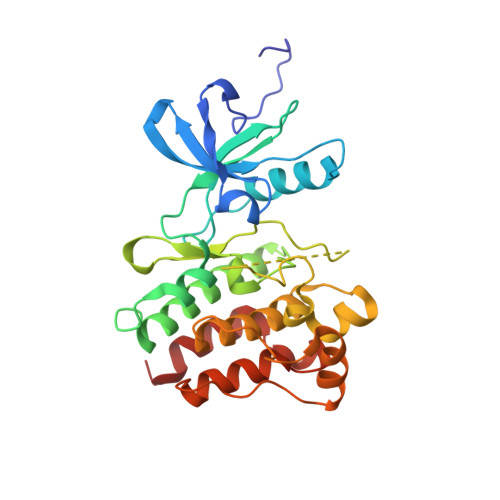Discovery and characterization of a novel potent type II native and mutant BCR-ABL inhibitor (CHMFL-074) for Chronic Myeloid Leukemia (CML)
Liu, F., Wang, B., Wang, Q., Qi, Z., Chen, C., Kong, L.L., Chen, J.Y., Liu, X., Wang, A., Hu, C., Wang, W., Wang, H., Wu, F., Ruan, Y., Qi, S., Liu, J., Zou, F., Hu, Z., Wang, W., Wang, L., Zhang, S., Yun, C.H., Zhai, Z., Liu, J., Liu, Q.(2016) Oncotarget 7: 45562-45574
- PubMed: 27322145
- DOI: https://doi.org/10.18632/oncotarget.10037
- Primary Citation of Related Structures:
5HU9 - PubMed Abstract:
BCR gene fused ABL kinase is the critical driving force for the Philadelphia Chromosome positive (Ph+) Chronic Myeloid Leukemia (CML) and has been extensively explored as a drug target. With a structure-based drug design approach we have discovered a novel inhibitor CHMFL-074, that potently inhibits both the native and a variety of clinically emerged mutants of BCR-ABL kinase. The X-ray crystal structure of CHMFL-074 in complex with ABL1 kinase (PDB ID: 5HU9) revealed a typical type II binding mode (DFG-out) but relatively rare hinge binding. Kinome wide selectivity profiling demonstrated that CHMFL-074 bore a high selectivity (S score(1) = 0.03) and potently inhibited ABL1 kinase (IC50: 24 nM) and PDGFR α/β (IC50: 71 nM and 88 nM). CHMFL-074 displayed strong anti-proliferative efficacy against BCR-ABL-driven CML cell lines such as K562 (GI50: 56 nM), MEG-01 (GI50: 18 nM) and KU812 (GI50: 57 nM). CHMFL-074 arrested cell cycle into the G0/G1 phase and induced apoptosis in the Ph+ CML cell lines. In addition, it potently inhibited the CML patient primary cell's proliferation but did not affect the normal bone marrow cells. In the CML cell K562 inoculated xenograft mouse model, oral administration of 100 mg/kg/d of CHMFL-074 achieved a tumor growth inhibition (TGI) of 65% without exhibiting apparent toxicity. As a potential drug candidate for fighting CML, CHMFL-074 is under extensive preclinical safety evaluation now.
Organizational Affiliation:
High Magnetic Field Laboratory, Chinese Academy of Sciences, Hefei 230031, Anhui, P. R. China.

















